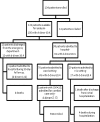A Pilot Study of the Performance Characteristics of the D-dimer in Presumed Sepsis
- PMID: 20823968
- PMCID: PMC2908653
A Pilot Study of the Performance Characteristics of the D-dimer in Presumed Sepsis
Abstract
Objectives: To determine if a sensitive D-dimer assay can exclude progression to organ dysfunction, death, and intensive care unit (ICU) admission in patients presenting to the emergency department (ED) with suspected infection, and if increasing levels of D-dimer are predictive of those end points.
Methods: The study took place at two academic EDs, both located in tertiary care hospitals. This was a prospective convenience sample of adult patients presenting with an infective process and at least two of four criteria for the Systemic Inflammatory Response Syndrome. We measured D-dimer levels in the participants and abstracted their records for the end points. Sensitivity and specificity were calculated and receiver operating characteristic analysis was performed to determine if a higher cutoff would have a greater specificity for our end points.
Results: We enrolled 134 patients. Twelve were excluded from analysis (10 for lack of a D-dimer, one for recent surgery, and one for complete loss to follow up). Using the cutoff of 0.4 established by our laboratories as positive, the D-dimer had a sensitivity of 94% (CI95; 76-99) for organ dysfunction in the ED, 93% (72-99) for organ dysfunction at 48 hours, 93% (81-98) for ICU admission, and 100% (63-100) for 30-day mortality. However, at this cutoff, specificity was not statistically significant. Significantly raising the cutoff for a positive resulted in a decrease in sensitivity but improved specificity.
Conclusion: This study was limited by its nonconsecutive patient recruitment and sample size. A normal D-dimer may exclude progression to organ dysfunction, ICU admission, and death and, at higher cutoff levels, could help risk stratify patients presenting to the ED with signs of sepsis.
Figures





Similar articles
-
Low sensitivity of qSOFA, SIRS criteria and sepsis definition to identify infected patients at risk of complication in the prehospital setting and at the emergency department triage.Scand J Trauma Resusc Emerg Med. 2017 Nov 3;25(1):108. doi: 10.1186/s13049-017-0449-y. Scand J Trauma Resusc Emerg Med. 2017. PMID: 29100549 Free PMC article.
-
Sepsis patients in the emergency department: stratification using the Clinical Impression Score, Predisposition, Infection, Response and Organ dysfunction score or quick Sequential Organ Failure Assessment score?Eur J Emerg Med. 2018 Oct;25(5):328-334. doi: 10.1097/MEJ.0000000000000460. Eur J Emerg Med. 2018. PMID: 28338533 Free PMC article.
-
[Diagnostic value of a combination of biomarkers in patients with sepsis and severe sepsis in emergency department].Zhonghua Wei Zhong Bing Ji Jiu Yi Xue. 2014 Mar;26(3):153-8. doi: 10.3760/cma.j.issn.2095-4352.2014.03.006. Zhonghua Wei Zhong Bing Ji Jiu Yi Xue. 2014. PMID: 24598287 Chinese.
-
The prevalence and diagnostic utility of systemic inflammatory response syndrome vital signs in a pediatric emergency department.Acad Emerg Med. 2015 Apr;22(4):381-9. doi: 10.1111/acem.12610. Epub 2015 Mar 16. Acad Emerg Med. 2015. PMID: 25778743
-
Sepsis Clinical Criteria in Emergency Department Patients Admitted to an Intensive Care Unit: An External Validation Study of Quick Sequential Organ Failure Assessment.J Emerg Med. 2017 May;52(5):622-631. doi: 10.1016/j.jemermed.2016.10.012. Epub 2016 Nov 4. J Emerg Med. 2017. PMID: 27823893
Cited by
-
A latent class approach for sepsis diagnosis supports use of procalcitonin in the emergency room for diagnosis of severe sepsis.BMC Anesthesiol. 2013 Sep 19;13(1):23. doi: 10.1186/1471-2253-13-23. BMC Anesthesiol. 2013. PMID: 24050481 Free PMC article.
-
Plasma d-Dimer Levels in Non-prosthetic Orthopaedic Implant Infection: Can it Aid Diagnosis?Indian J Orthop. 2020 Apr 24;54(Suppl 1):76-80. doi: 10.1007/s43465-020-00120-8. eCollection 2020 Sep. Indian J Orthop. 2020. PMID: 32952913 Free PMC article.
-
COVID-19 Sepsis: Pathogenesis and Endothelial Molecular Mechanisms Based on "Two-Path Unifying Theory" of Hemostasis and Endotheliopathy-Associated Vascular Microthrombotic Disease, and Proposed Therapeutic Approach with Antimicrothrombotic Therapy.Vasc Health Risk Manag. 2021 Jun 1;17:273-298. doi: 10.2147/VHRM.S299357. eCollection 2021. Vasc Health Risk Manag. 2021. PMID: 34103921 Free PMC article. Review.
-
Impact of d-Dimers on the Differential Diagnosis of Acute Chest Pain: Current Aspects Besides the Widely Known.Clin Med Insights Cardiol. 2014 Oct 19;8(Suppl 2):1-4. doi: 10.4137/CMC.S15948. eCollection 2014. Clin Med Insights Cardiol. 2014. PMID: 25392700 Free PMC article. Review.
-
Usefulness of serum D‑dimer for preoperative diagnosis of infected nonunion after open reduction and internal fixation.Infect Drug Resist. 2019 Jul 1;12:1827-1831. doi: 10.2147/IDR.S213099. eCollection 2019. Infect Drug Resist. 2019. PMID: 31308705 Free PMC article.
References
-
- Rivers E, Nguyen B, Havstad S, et al. Early Goal Directed Therapy in the treatment of severe sepsis and septic shock. N Engl J Med. 2001;345:1368–77. - PubMed
-
- Kumar A, Roberts D, Wood KE, et al. Duration of hypotension before initiation of effective antimicrobial therapy is the critical determinant of survival in human septic shock. Crit Care Med. 2006;34:1589–96. - PubMed
-
- Alberti C, Brun-Buisson C, Goodman SV, et al. Influence of Systemic Inflammatory Response Syndrome and Sepsis on Outcome of Critically Ill and Infected Patients. Am J Respir Crit Care Med. 2003;168:77–84. - PubMed
-
- Deitcher SR, Eisenberg PR. Elevated concentrations of cross-linked fibrin degradation products in plasma. An early marker of gram-negative bacteremia. Chest. 1993;103:1107–12. - PubMed
